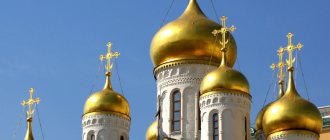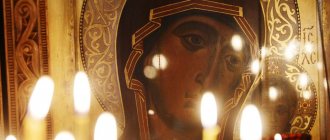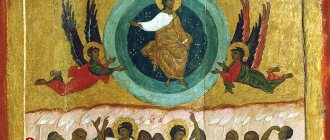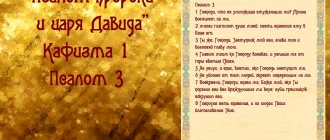The sign of the cross is the main prayer gesture used in Orthodoxy. By moving his hands, the believer depicts a cross, making the sign of himself with it. In religion, there are a large number of situations in which it is considered necessary to make the sign of the cross. It is performed at the entrance and exit from the temple, during services and prayers, at the time of confession, as well as when blessing someone and in other situations. Crossing is customary in most Christian denominations, and there are a large number of options for adding fingers and hand movements.
What do folded fingers symbolize?
Photo: Flickr.com
In Orthodoxy, there is a certain tradition of making the sign of the cross. To do this, you need to put three fingers of your right hand together. This must be the index thumb and middle finger. In this case, the little finger and ring finger remain pressed to the palm.
The fingers placed together symbolize the trinity. By this, Orthodox Christians demonstrate that they honor the Father, Son and Holy Spirit. In Orthodoxy this is the indivisible Trinity.
The two fingers remaining pressed to the palm also carry a symbolic meaning. They signify the human and divine essence of Jesus Christ.
To make the sign of the cross, an Orthodox believer must touch his forehead with folded fingers. So he sanctifies his mind and thoughts, then to his stomach, sanctifying his inner feelings. Next to the right and then to the left shoulder, consecrating bodily strength.
10.26.2016 We all know very well what an exceptional role the sign of the cross plays in the spiritual life of an Orthodox Christian. Every day, during morning and evening prayers, during worship and before eating food, before the beginning of teaching and at its end, we place on ourselves the sign of the Honest and Life-giving Cross of Christ. And this is not accidental, because in Christianity there is no more ancient custom than the sign of the cross, i.e. overshadowing oneself with the sign of the cross. At the end of the third century, the famous Carthaginian church teacher Tertullian wrote: “When traveling and moving, entering and leaving a room, putting on shoes, taking a bath, at the table, lighting candles, lying down, sitting down, in everything we do, we must overshadow your forehead with a cross." A century after Tertullian, St. John Chrysostom wrote the following: “Never leave home without crossing yourself.” As we see, the sign of the cross has come to us from time immemorial, and without it our daily worship of God is unthinkable. However, if we are honest with ourselves, it will become absolutely obvious that quite often we make the sign of the cross out of habit, mechanically, without thinking about the meaning of this great Christian symbol. I believe that a short historical and liturgical excursion will allow all of us subsequently to more consciously, thoughtfully and reverently apply the sign of the cross to ourselves. So what does the sign of the cross symbolize and under what circumstances did it arise? The sign of the cross, which has become part of our daily life, arose quite late, and entered the liturgical life of the Russian Orthodox Church only in the 17th century, during the well-known reforms of Patriarch Nikon. In the Ancient Church, only the forehead was marked with a cross. Describing the liturgical life of the Roman Church in the 3rd century, Hieromartyr Hippolytus of Rome writes: “Always try to humbly sign the sign of the cross on your forehead.” The use of one finger in the sign of the cross is then spoken about by: St. Epiphanius of Cyprus, Blessed Jerome of Stridon, Blessed Theodoret of Cyrrhus, church historian Sozomen, St. Gregory the Dvoeslov, St. John Moschos, and in the first quarter of the 8th century, St. Andrew of Crete. According to the conclusions of most modern researchers, marking the forehead (or face) with a cross arose during the time of the apostles and their successors. Moreover, this may seem incredible to you, but the appearance of the sign of the cross in the Christian Church was significantly influenced by Judaism. A fairly serious and competent study of this issue was carried out by the modern French theologian Jean Danielou. You all remember very well the Council in Jerusalem described in the book of the Acts of the Apostles, which took place approximately in the 50th year of the Nativity of Christ. The main question that the apostles considered at the Council concerned the method of accepting into the Christian Church those people who had been converted from paganism. The essence of the problem was rooted in the fact that our Lord Jesus Christ preached his sermon among the Jewish chosen people of God, for whom even after
acceptance of the Gospel Message, all religious and ritual prescriptions of the Old Testament remained binding. When the apostolic preaching reached the European continent and the early Christian Church began to be filled with newly converted Greeks and representatives of other nations, the question of the form of their acceptance quite naturally arose. First of all, this question concerned circumcision, i.e. the need for converted pagans to first accept the Old Testament and be circumcised, and only after that accept the Sacrament of Baptism. The Apostolic Council resolved this dispute with a very wise decision: for Jews, the Old Testament Law and circumcision remained mandatory, but for pagan Christians, Jewish ritual regulations were abolished. By virtue of this decree of the Apostolic Council, in the first centuries there were two most important traditions in the Christian Church: Judeo-Christian and linguistic-Christian. Thus, the Apostle Paul, who constantly emphasized that in Christ “there is neither Greek nor Jew,” remained deeply attached to his people, to his homeland, to Israel. Let us remember how he speaks about the election of the unbelievers: God chose them in order to awaken zeal in Israel, so that Israel would recognize in the person of Jesus the Messiah they were waiting for. Let us also remember that after the death and Resurrection of the Savior, the apostles regularly gathered in the Jerusalem Temple, and they always began their preaching outside Palestine from the synagogue. In this context, it becomes clear why the Jewish religion could have a certain influence on the development of external forms of worship of the young early Christian Church.
So, returning to the question of the origin of the custom of making the sign of the cross, we note that in the Jewish synagogue worship of the times of Christ and the apostles there was a ritual of inscribing the name of God on the forehead. What is it? The book of the prophet Ezekiel (Ezekiel 9:4) speaks of a symbolic vision of a catastrophe that should befall a certain city. However, this destruction will not affect pious people, on whose foreheads the angel of the Lord will depict a certain sign. This is described in the following words: “And the Lord said to him: go through the middle of the city, in the middle of Jerusalem, and make a sign on the foreheads of the mourning people, sighing over all the abominations that are being committed in its midst.” Following the prophet Ezekiel, the same mark of the name of God on the forehead is mentioned in the book of Revelation of the holy Apostle John the Theologian. Thus, in Rev. 14:1 says: “And I looked, and behold, a Lamb stood on Mount Zion, and with him an hundred and forty-four thousand, having the name of His Father written on their foreheads.” Elsewhere (Rev. 22.3-4) the following is said about the life of the next century: “And nothing will be cursed any more; but the throne of God and of the Lamb will be in it, and His servants will serve Him. And they will see His face, and His name will be on their foreheads.”
What is the name of God and how can it be depicted on the forehead? According to ancient Jewish tradition, the name of God was symbolically imprinted by the first and last letters of the Jewish alphabet, which were “alef” and “tav.” This meant that God is Infinite and Almighty, Omnipresent and Eternal. He is the completeness of all conceivable perfections. Since a person can describe the world around him with the help of words, and words consist of letters, the first and last letters of the alphabet in the writing of the name of God indicate that He contains the fullness of being, He embraces everything that can be described in human language. By the way, the symbolic inscription of the name of God using the first and last letters of the alphabet is also found in Christianity. Remember, in the book of the Apocalypse, the Lord says about himself: “I am alpha and omega, the beginning and the end.” Since the Apocalypse was originally written in Greek, it became obvious to the reader that the first and last letters of the Greek alphabet in the description of the name of God testify to the fullness of Divine perfections. Often we can see iconographic images of Christ, in whose hands is an open book with the inscription of only two letters: alpha and omega. According to the passage from Ezekiel's prophecy quoted above, the elect will have the name of God inscribed on their foreheads, which is associated with the letters "aleph" and "tav." The meaning of this inscription is symbolic - a person who has the name of God on his forehead has completely given himself to God, dedicated himself to Him and lives according to the Law of God. Only such a person is worthy of salvation. Wanting to outwardly demonstrate their devotion to God, the Jews of the time of Christ already inscribed the letters “alef” and “tav” on their foreheads. Over time, in order to simplify this symbolic action, they began to depict only the letter “tav”. It is quite remarkable that the study of manuscripts of that era showed that in Jewish writing at the turn of the era, the capital “tav” had the shape of a small cross. This small cross meant the name of God. In fact, for a Christian of that era, the image of a cross on his forehead meant, as in Judaism, dedicating his entire life to God. Moreover, placing a cross on the forehead was no longer reminiscent of the last letter of the Hebrew alphabet, but rather the sacrifice of the Savior on the cross. When the Christian Church finally freed itself from Jewish influence, then the understanding of the sign of the cross as an image of the name of God through the letter “tav” was lost. The main semantic emphasis was placed on the display of the Cross of Christ. Having forgotten about the first meaning, Christians of later eras filled the sign of the Cross with new meaning and content.
Around the 4th century, Christians began to sign the cross over their entire body, i.e. the “wide cross” we know appeared. However, the imposition of the sign of the cross at this time still remained single-finger. Moreover, by the 4th century, Christians began to sign the cross not only on themselves, but also on surrounding objects. Thus, a contemporary of this era, the Monk Ephraim the Syrian writes: “The life-giving cross overshadows our houses, our doors, our lips, our breasts, all our members. You, Christians, do not leave this cross at any time, at any hour; may he be with you in all places. Do nothing without the cross; whether you go to bed or get up, work or rest, eat or drink, travel on land or sail on the sea - constantly adorn all your members with this life-giving cross.” In the 9th century, single-fingered fingers gradually began to be replaced by double-fingered fingers, which was due to the widespread spread of the heresy of Monophysitism in the Middle East and Egypt. When the heresy of the Monophysites appeared, it took advantage of the hitherto used form of finger formation - one-finger - to propagate its teachings, since it saw in one-finger a symbolic expression of its teaching about the one nature in Christ. Then the Orthodox, contrary to the Monophysites, began to use two fingers in the sign of the cross, as a symbolic expression of the Orthodox teaching about two natures in Christ. It so happened that the one-fingered sign of the cross began to serve as an external, visual sign of Monophysitism, and the two-fingered sign of Orthodoxy. Thus, the Church again inserted deep doctrinal truths into the external forms of worship. An earlier and very important evidence of the use of double fingers by the Greeks belongs to the Nestorian Metropolitan Elijah Geveri, who lived at the end of the 9th century. Wanting to reconcile the Monophysites with the Orthodox and the Nestorians, he wrote that the latter disagreed with the Monophysites in the depiction of the cross. Namely, some depict the sign of the cross with one finger, leading the hand from left to right; others with two fingers, leading, on the contrary, from right to left. Monophysites, crossing themselves with one finger from left to right, emphasize that they believe in one Christ. Nestorians and Orthodox Christians, depicting the cross in the sign with two fingers - from right to left, thereby profess their belief that on the cross humanity and divinity were united together, that this was the reason for our salvation. In addition to Metropolitan Elijah Geveri, the well-known Venerable John of Damascus also wrote about double-fingering in his monumental systematization of Christian doctrine, known as “An Accurate Exposition of the Orthodox Faith.”
Around the 12th century, in the Greek-speaking Local Orthodox Churches (Constantinople, Alexandria, Antioch, Jerusalem and Cyprus), two-fingered was replaced by three-fingered. The reason for this was seen as follows. Since by the 12th century the struggle with the Monophysites had already ended, double-fingering lost its demonstrative and polemical character. However, double-fingering made Orthodox Christians related to the Nestorians, who also used double-fingering. Wanting to make a change in the external form of their worship of God, the Orthodox Greeks began to sign themselves with the three-fingered sign of the cross, thereby emphasizing their veneration of the Most Holy Trinity. In Rus', as already noted, triplicate was introduced in the 17th century during the reforms of Patriarch Nikon. Thus, to summarize this message, it can be noted that the sign of the Honest and Life-giving Cross of the Lord is not only the oldest, but also one of the most important Christian symbols. It requires a deep, thoughtful, and reverent attitude from us. Centuries ago, John Chrysostom admonished us to think about this with these words: “You must not just draw a cross with your fingers,” he wrote. “You have to do it in faith.”
Hegumen PAVEL, candidate of theology, inspector of the Ministry of Education and Science minds.by
IN THE TOPIC Why not three fingers?
Usually believers of other faiths, for example, New Believers, ask why Old Believers do not cross themselves with three fingers, like members of other Eastern churches. To this, the Old Believers respond: Two-fingered fingers were commanded to us by the apostles and fathers of the ancient Church, for which there is a lot of historical evidence. Three fingers is a newly invented ritual, the use of which has no historical justification.
The keeping of two fingers is protected by a church oath, which is contained in the ancient rite of acceptance from heretics by Jacobite and the decrees of the Council of the Hundred Heads in 1551: “If anyone does not blesh with two fingers as Christ did, or does not imagine the sign of the cross, let him be damned.” The two-fingered sign reflects the true dogma of the Christian Creed - the crucifixion and resurrection of Christ, as well as the two natures in Christ - human and Divine. Other types of the sign of the cross do not have such dogmatic content, but the three-fingered sign distorts this content, showing that the Trinity was crucified on the cross. And although the New Believers do not contain the doctrine of the crucifixion of the Trinity, the Holy Fathers categorically prohibited the use of signs and symbols that have heretical and non-Orthodox meaning. Thus, polemicizing with Catholics, the holy fathers also pointed out that the mere change in the creation of a species, the use of customs similar to heretical ones, is in itself a heresy. Ep. Nikolas of Methonsky wrote, in particular, about unleavened bread: “Whoever consumes unleavened bread is already suspected of communicating with these heresies because of some similarity.” The truth of the dogmatics of two fingers is recognized today, although not publicly, by various New Believer hierarchs and theologians. So oh. Andrey Kuraev in his book “Why the Orthodox are like this” points out: “I consider two-fingered to be a more accurate dogmatic symbol than three-fingered. After all, it was not the Trinity that was crucified, but “one of the Holy Trinity, the Son of God.”
Source: ruvera.ru
So how to be baptized correctly? Compare several photographs presented. They are taken from various open sources.
His Holiness Patriarch Kirill of Moscow and All Rus' and Bishop Anthony of Slutsk and Soligorsk clearly use two fingers. And the rector of the Church of the Icon of the Mother of God “Healer” in the city of Slutsk, Archpriest Alexander Shklyarevsky and parishioner Boris Kleshchukevich folded three fingers of their right hand. Probably, the question still remains open and different sources answer it differently. St. Basil the Great also wrote: “In the Church, let everything happen in order and in order.” The sign of the cross is a visible evidence of our faith. To find out whether the person in front of you is Orthodox or not, you just need to ask him to cross himself, and by how he does it and whether he does it at all, everything will become clear. And let us remember the Gospel: “He who is faithful in little is also faithful in much” (Luke 16:10). Here, for example, is how the website of the Church of Stephen of Perm (Moscow) recommends baptism. The sign of the cross is a visible evidence of our faith, so it must be performed carefully and with reverence. The power of the Sign of the Cross is unusually great. In the Lives of the Saints there are stories about how demonic spells were dispelled after the overshadowing of the Cross. Therefore, those who are baptized carelessly, fussily and inattentively simply please the demons. How to make the Sign of the Cross correctly? 1) You need to put three fingers of your right hand (thumb, index and middle) together, which symbolizes the three faces of the Holy Trinity - God the Father, God the Son and God the Holy Spirit. By joining these fingers together, we testify to the unity of the Holy Indivisible Trinity. 2) The other two fingers (little finger and ring finger) are bent tightly to the palm, thereby symbolizing the two natures of the Lord Jesus Christ: Divine and human. 3) First, folded fingers are placed on the forehead to sanctify the mind; then on the stomach (but not lower) - to sanctify internal abilities (will, mind and feelings); after that - on the right and then on the left shoulder - to sanctify our bodily strength, because the shoulder symbolizes activity (“to lend a shoulder” - to provide assistance). 4) Only after lowering the hand do we bow from the waist so as not to “break the Cross.” This is a common mistake - bowing at the same time as the Sign of the Cross. This should not be done. The bow after the Sign of the Cross is performed because we have just depicted (overshadowed ourselves) the Calvary Cross, and we worship it. In general, at present, on the question “How to be baptized?” Many people don't pay attention. For example, in one of his blogs, Archpriest Dimitry Smirnov writes that “... the truth of the Church is not tested by how a person feels in its church: good or bad... being baptized with two or three fingers no longer plays any role, because these two rites are recognized Church of equal honor." Archpriest Alexander Berezovsky also confirms there: “Be baptized as you like.” This illustration was posted on the website of the Church of the Pochaev Icon of the Mother of God in the village of Lyubimovka, Sevastopol, Crimea.
Here is a reminder for those who are just joining the Orthodox Church and still don’t know much. A kind of alphabet. When should you be baptized? In church: It is imperative to be baptized at the moment the priest reads the Six Psalms and when the Creed begins to be chanted. It is also necessary to make the sign of the cross at those moments when the clergyman says the words: “By the power of the Honest and Life-giving Cross.” You need to be baptized when the paremias begin. It is necessary to be baptized not only before entering the church, but also after you leave its walls. Even when passing by any temple, you must cross yourself once. After a parishioner venerates an icon or cross, he must also cross himself. On the street: When passing by any Orthodox church, you should be baptized for the reason that in every church in the altar, on the throne, Christ himself dwells, the Body and Blood of the Lord in the chalice, which have all the fullness of Jesus Christ. If you do not cross yourself when passing by the temple, you should remember the words of Christ: “For whoever is ashamed of Me and My words in this adulterous and sinful generation, of him will the Son of Man also be ashamed when he comes in the glory of His Father with the holy angels” (Mark. 8:38). But, you should understand the reason why you did not cross yourself, if it is embarrassment, then you should cross yourself, if this is impossible, for example, you are driving and your hands are busy, then you should cross yourself mentally, also you should not cross yourself, if for This can become a reason for others to ridicule the church, so you should understand the reason. At home: immediately after waking up and immediately before going to bed; at the beginning of reading any prayer and after its completion; before and after meals; before starting any work.
Selected and prepared materials by Vladimir KHVOROV
The origins of the tradition of the sign of the cross
Photo: Stihi.ru
This symbolic tradition in Christianity appeared during the time of the first apostles, followers of Jesus Christ. This is a general opinion held by all theologians without exception.
The very first historical information about the emergence of the tradition of making the sign of the cross dates back to the beginning of the 3rd century. The author of the era of early Christianity, Quintus Tertullian, writes about this, leaving behind about 30 religious treatises.
He writes specifically about the sign of the cross in his treatise “On the Warrior’s Crown,” noting that Christians have a tradition of “protecting” themselves with the sign of the cross in almost any life circumstances. For example, when entering church, leaving home, before going to bed, or after completing some important task.
Historians attribute this treatise to the year 211, which indicates that in the time that has passed since the crucifixion of Christ, the tradition of making the sign of the cross has firmly entered the life of believers, becoming one of the fundamental traditions.
The meaning of the Orthodox cross
The cross is the confession of faith of Orthodox Christians. It recalls the suffering of the Savior on the cross, which He endured to save sinners from hell and return to the Kingdom of Heaven. In general, death on the cross was considered the most terrible and shameful death. Men who committed a particularly serious crime indulged in it. On the cross, the hands and feet were nailed. Death occurred from suffocation, heart rupture and blood loss. They died on the cross painfully for long hours, and sometimes even days.
M. Gibson's film “The Passion of the Christ”
Christ chose the most painful death in order to take upon himself the sins of all mankind. Now sinners can repent to Him and receive forgiveness right there, thanks to such a terrible sacrifice of Christ. People do not fully realize the importance and greatness of the Savior’s feat for their sake. As well as the fact that the torment on the cross looked much more terrible than it is shown in icons, paintings and even Hollywood films.
Everyone knows M. Gibson's film "The Passion of the Christ" , which is simply impossible to watch due to the abundance of bloody scenes and torment. But even he could not convey the full horror of Christ’s suffering. On the cross the people were completely naked, and everyone was looking at them. Before this, Christ suffered severe beatings and scourging, so His body turned into a bloody mass. Then He carried the crossbar from the cross to Golgotha.
In order for the arms to stay on the crossbar, they were stretched, as a result, the joints of the arms were dislocated. In addition to the pain from the nails and dislocation, He experienced terrible suffocation and thirst. He had to constantly move to get air. He didn't hang motionless like in the movie. He was dehydrated, his pulse rose to 200, his blood pressure dropped to 70 over 40. Christ experienced vascular collapse and severe heart failure. He had severe convulsions. In addition, He experienced God-forsakenness; the Heavenly Father turned away from Him. This, perhaps, was the most terrible torment for Him.
Christ experienced all this in order to take upon Himself the sins of all mankind, so that we could enter the Kingdom of Heaven . In such suffering for people, one can see not only enormous patience, but unspeakable love. After all, He took all this upon Himself voluntarily!
That is why the cross as a symbol speaks volumes to believers. The Orthodox treat him very reverently. You cannot, for example, depict crosses on the floor, so as not to accidentally step on them. In every home, believers have a crucifix to which they bow and kiss.
Therefore, believers make the sign of the cross as often as possible as a sign of veneration for the Savior’s suffering on the cross. The Apostle Paul wrote: “for the Jews the cross is a temptation, for the Greeks it is foolishness, but for us it is God’s power and wisdom,” also: “I carry the deadness of the Lord in my body.”
Evolution of the symbolism of the sign of the cross
Photo: Ruvera.ru
It is interesting that the sign of the cross did not always mean what it symbolizes now. In early Christianity, it was customary to cross with only one finger. By this, believers demonstrated to others that they believed in only one God, in contrast to the more popular pagans at that time who preached polytheism.
At the Council of 325, a key decision was made when the leaders of the Christian church decided to cross themselves with two fingers, symbolizing the two natures of Jesus Christ. The situation began to change after the emergence of heresies, which began to deny the seemingly unshakable dogma of the Holy Trinity. This led to serious divisions among the Orthodox. As a result, in the 11th century, it was decided to make the sign of the cross, consisting of three fingers, in order to finally establish the dogma of the Holy Trinity.
At the same time, in Rus' they did not know about the custom of three fingers for about 500 years, continuing to cross themselves with two fingers. This tradition was changed by Patriarch Nikon shortly after the accession of Alexei Mikhailovich to the throne. This decision provoked a church schism; some parishioners refused to accept the innovations. They are known as schismatics and still exist today.
“I am the alpha and omega”
Some theologians talk about the origin of the sign of the cross in the name of God, inscribed on the foreheads of His chosen ones, whom the Old Testament prophet Ezekiel and the Apostle John observed in visions. It is believed that the name of God was inscribed in the form of the first and last letters of the Jewish alphabet “alef” and “tav”, the outline of which in a simplified version was a cross. Later, the cross began to cover the entire body.
In Orthodoxy, the custom of laying a cross on oneself is not just some kind of obligatory prayer gesture, but a physical expression of the dogmas of faith, confession of the Holy Trinity and the God-man Christ, an expression of gratitude, love, protection from demonic power and readiness to accept any will of God.
Is it necessary to be baptized in public places?
To answer this question, you need to clearly understand the meaning of the sign of the cross:
- By putting a symbolic cross on his body, a person confirms his faith in Jesus Christ, and therefore in his teaching, and in the fact that through suffering on Calvary he sacrificed himself for the salvation of all mankind.
- Making the sign of the cross should never be automatic; every movement should be permeated with love for God.
- You cannot be baptized just to show in society that you lead a righteous and pious life.
- At the same time, the Lord called us to preaching, so we cannot hide our feelings and faith in Christ. If you feel a sincere desire to cross yourself, then do it.
Although it is undeniable that one must be baptized according to accepted tradition, this is far from the main thing. It is much more important to accept God in your heart and devote your life to service and keeping the commandments. Therefore, one should not condemn those who incorrectly cross themselves. It’s better to come up and show the person how to do it. Moreover, now you know everything about how it is customary to be baptized in Orthodoxy.
How to be baptized correctly
An Orthodox person should be baptized slowly: first, the believer touches his forehead with three fingers, which signifies the sanctification of the mind, then the stomach, which means the sanctification of the feelings (heart), then the right shoulder, and then the left (which symbolizes the sanctification of the whole body).
You should bow only at the end of the sign of the cross - you can bow your head slightly, bow from the waist, or bow to the ground.
The sign of the cross, performed with faith and reverence, is a spiritual weapon, which the unclean fears and with which many saints have accomplished many glorious deeds.
For example, the Apostle John once healed with the sign of the cross a man lying in a fever, whom he found unconscious on the road - this was written by Bishop Dmitry of Rostov in the Life of the Saint.
The Monk Abba Dorotheos made the sign of the cross over the water in which the poisonous adder was located, and drank it without fear, indicating that the cross expels Satan and neutralizes his malice. Saint Benedict of Nursia (480-543) neutralized the poison that was poured into his wine with the sign of the cross, and the cups consecrated by the cross were immediately broken.
The Russian saint Nektarios of Optina blessed heavy objects with a cross so that they could be lifted.
The sign of the cross is not only a weapon, but also a tool that allows a person to determine who is in front of him: an angel or a demon pretending to be an angel. Saint Anthony the Great pointed out that if an “angel” comes to a prayer book at night and wants to distract him from prayer, the person should cross himself, and then the demon will immediately disappear.
The sign of the cross will help the human soul, even after it leaves the body after death and can be tempted by the devil, who turns into an angel. To distinguish who is standing in front of him, a person should ask him to cross himself - the angel will do this without delay, but the unclean one will not be able to.
In Orthodoxy there is even a special prayer dedicated to the All-Honorable Cross of the Lord, which is addressed not to an object, but to God the Creator, and begins with the words of King David (Psalm 67): “May God rise again, and may His enemies be scattered, and may they flee from His presence.” those who hate Him. As smoke disappears, let them disappear, as wax melts before the fire, so let sinners perish before the face of God.”
This prayer is read with the consecration of oneself with the sign of the cross and is very effective in dealing with demonic misfortunes and various temptations.
Prayer by agreement Church Slavonic
Lord Jesus Christ, Son of God, Thou hast declared with Thy most pure lips: “Amen, I say to you, that if two of you take counsel on earth about every thing, and if you ask for it, you will have it from My Father who is in Heaven: where are the two? or three gathered in My name, I am I in the midst of them.” Thy words are immutable, O Lord, Thy mercy is unconditional and Thy love for mankind has no end. For this reason, we pray to Thee: grant to us, Thy servants (names), who have agreed to ask Thee (request), the fulfillment of our request. But not as we want, but as You want. Thy will be done forever. Amen.
How did the tradition of making the sign of the cross come about?
It is believed that this tradition dates back to the times of the apostolic sermons. It came to us not through written traditions, but through the preservation of custom. Everywhere where people accepted faith in Christ and his suffering on the cross, they depicted a cross on themselves.
Some crossed themselves with their entire palm, while African peoples made the sign of the cross with just one finger. Some baptized only the area of their heart or mouth. In Egypt, Copts tattooed a cross on their body so that no one could remove this symbol of faith from them. In Orthodoxy, parents of children and priests often make the sign of the cross over their flock, so the sign acts as protection against the enemy of the human race.
It was from the time of the Apostles that differences began in the way of making the sign of the cross. This is probably due to the cultural characteristics of national ethnic groups that have adopted faith in one God. For example, Catholics cross with their left hand from left to right, while Orthodox Christians use their right hand and make the symbol from right to left.
In addition, there are many other differences between Christian denominations in the course of services and the vestments of priests. But the most important thing that unites everyone is faith in the Savior and his sacrifice. And even though many rituals have become infinitely distant over several centuries, for example, the Eucharistic law in the Orthodox and Catholic churches is identical.
Is God or man at the center of the world?
The origin of the Catholic sign of the cross, when a Catholic believer crosses himself from left to right, is not entirely clear. Orthodox theologians believe that this discrepancy is caused by a worldview that differs between Catholics and Orthodox Christians.
In the life of European man, individualism and anthropocentrism predominate; man himself stands at the center of the European world, while the consciousness of the Orthodox believer is theocentric and places God the Creator at the center of everything. The sign of the cross from right to left symbolizes God's blessing, and if the hand moves from left to right, it means that the person is turning to God.
Prayer by agreement in Russian
Lord Jesus Christ, Son of God, You said with Your most pure lips: “Truly I say to you, that if two of you agree on earth about anything they ask, it will be done for them by My Father in Heaven, for where there are two or three are gathered in my name, there am I in the midst of them.” Your words are immutable, O Lord, your mercy is unconditional and your love for mankind has no end. For this reason, we pray to You: grant to us, Your servants (the names of those asking), who have agreed to ask You for (the petition) the fulfillment of our petition. But let it be not as we want, but as You, Lord, may Your will be done forever. Amen










